There are hundreds of helpful tips on how to make progress in dog training. However, there is only one POWERFUL rule on how to make dog training successful: sending a clear message to your dog.
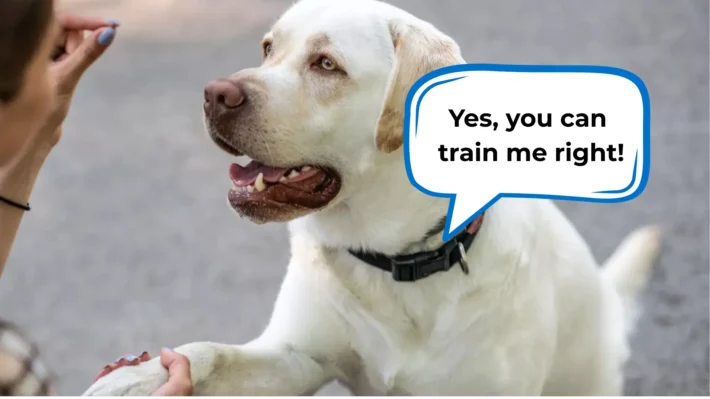
In this blog, we’re talking about the dog training benefits of delivering a clear expectation to your dog, and how sticking to it can massively impact dog training!
Read on to learn more.
Key Takeaways
- Consistency in routine, messaging, and activities can significantly predict whether your training will fail or will succeed.
- Seemingly harmless habits like letting your dog sleep on your bed, or making the dog take the lead are actually harming your training.
- Professional dog training services — whether done in person or with an online dog training program — can change the direction of your training.
Table of Contents
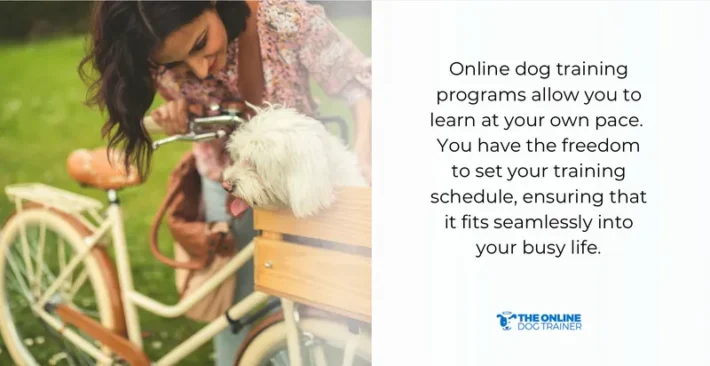
The Story of Chief: How to Make Dog Training Successful With Rules and Boundaries
If there’s one thing I have learned from working with thousands of dog owners, it is this: furparents do things out of love.
And love is a great tool in dog training. However, on the flip-side, love can also be detrimental to a dog’s progress.
(I talk more about Chief’s story in the video below. )
Let me share with you the story of Chief.
Chief — a dog I had the lovely honor to have a consultation with — was showing challenging behavior to his dog owners.
He was stressed, he had behavioral issues, and no training seemed to work.
While talking with me, his owner suddenly added “But Jack sleeps with us on the bed. In fact he sleeps on my husband’s head!”
Now, if you’re familiar with my dog training principles, you would know that hearing her words was a lightbulb moment.
AHA!
I knew exactly what the root of the problem was.

Chief felt he was in charge. No matter how lovingly his dog owners care for him, he still felt in charge.
And even though the decision to let Chief sleep on the bed was done out of love, it truly affected how the training was working for the family.
What Makes Dog Training Successful: Stick To Your Word, Stick To Consistency
“Leaders walk the talk… and they keep walking.” – Tejraj Singh Anand
I read that quote a few days ago, and I felt like it communicates clearly why inconsistencies make dog training fail.
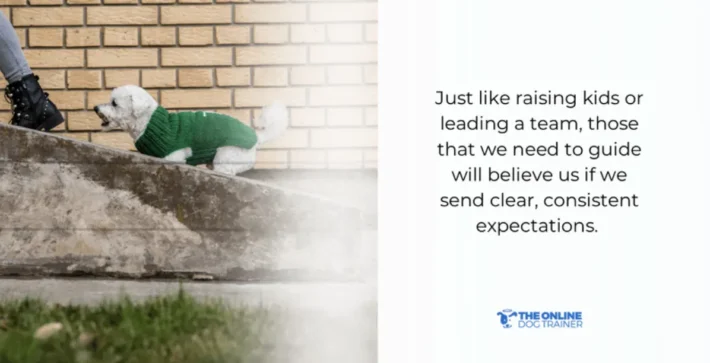
Just like raising kids or leading a team, those that we need to guide will believe us if we send clear, consistent expectations.
#1: A Successful Dog Training Includes Consistency With Your Message
Consistency is key when it comes to successful dog training because dogs thrive on routine and clear communication.
One common mistake that can hinder progress is sending mixed signals to your furry friend.
You’re training them to not scratch on the furniture, but you may not be using timeouts when they do.
You want your dogs to see you as a leader, but your actions could be telling your dog “I can boss this human around!”
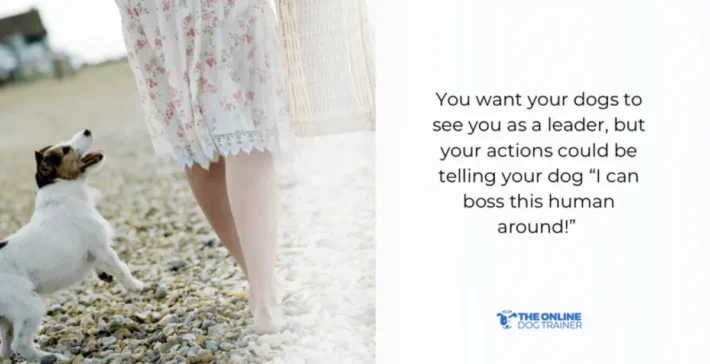
Successful dog training stars with a clear, consistent message — one that you 100% stick to.
Make sure everyone involved in the training process — including family members and housemates — is on the same page.
Consistency in the commands, gestures, and expectations will prevent confusion and provide a solid foundation for your dog's learning.
#2: Dog Training Success Comes With a Routine Aligned to Your Goals
A well-planned and consistent routine provides structure and clarity for both you and your dog. Additionally, a great routine paves the way to effective learning and progress.
Not having a consistent messaging and routine during dog training can lead to confusion, frustration, and hindered progress.

Dogs rely on clear communication and structure. Inconsistency can result in mixed signals, behavioral issues, and a lack of trust between you and your dog.
The first step in creating a routine is to define your training goals.
What specific behaviors or commands do you want your dog to learn? Are there any particular challenges or behavior issues you need to address?
By clearly identifying your objectives, you can tailor your routine to focus on the areas that require attention.
#3: Sticking To The Right Training Even After Making Mistakes
Embrace the mindset that mistakes are part of the journey.
Dogs are incredibly forgiving and resilient, and they respond well to consistent and patient training efforts.

By remaining committed to the right dog training path, even when mistakes occur, you demonstrate your dedication and desire to improve the relationship with your dog.
Adapt your training approach, reinforce the correct behaviors, and maintain a positive and encouraging attitude.
Remember that your dog looks to you for guidance and relies on your consistent messaging and support.
Show them empathy, understanding, and patience as you navigate the training process together.
How to Make Dog Training Successful: 5 Ways to Remain Consistent in Your Training
Now that we have established that consistency IS KEY to dog training success, here are five ways that you can make consistency possible.
#1: Establish Clear Rules and Expectations
Consistency starts with clearly defining the rules and expectations for your dog.
If they did something positive, use positive reinforcements and really great treats.
But if a behavior issue arises, communicate to your dog immediately that what they did wrong, and use timeouts if necessary.
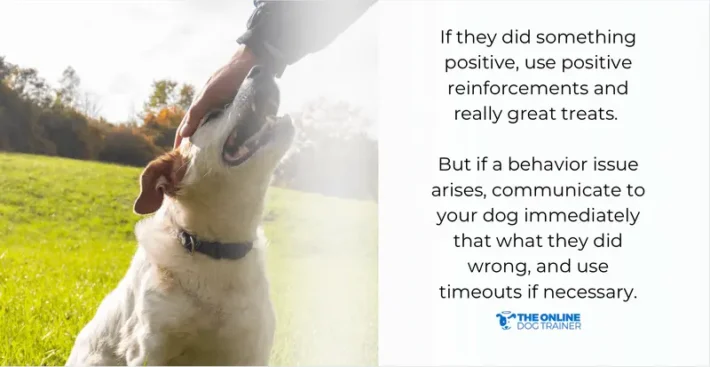
Be consistent in what behaviors are acceptable and what are not. Communicate these expectations to everyone involved in your dog's care.
#2: Stick to a Regular Training Schedule
The best partner to staying consistent in dog training is observing a routine and really sticking to it.
Set aside dedicated times for training sessions and follow your schedule regularly. Regularity helps your dog understand that training is a consistent part of their daily life.
#3: Use Consistent Verbal Cues and Commands
Ensure that you use the same verbal cues and commands consistently.
Teach your dog specific words for each behavior and use them consistently across all training sessions.
#4: Reinforce Positive Behavior Consistently
Reward your dog consistently for displaying the desired behaviors.
This can be in the form of treats, pats and cuddles, or playtime.
Consistent positive reinforcement strengthens the association between the behavior and the reward.

#5: Stay Calm and Patient
Consistency requires a calm and patient demeanor
Avoid getting frustrated or angry during training sessions. Dogs respond better to a positive and patient approach, which fosters a trusting and conducive learning environment.
Frequently Asked Questions About Dog Training
What is the best dog training technique?
This is a question I hear all the time, and it's a great one. We get so caught up in the specifics—treats, clickers, corrections—that we miss the forest for the trees. The truth is, there isn't one single “best” technique in the way you might think. All techniques, no matter how clever or well-researched, will fail without the one true foundation: consistency in your message.
Think of it like building a house. You can have the most expensive tools and the most beautiful plans, but if you don't lay a solid foundation, the whole house will eventually fall. Your clear, consistent message is that foundation. Your dog needs to know what you expect, every single time, without fail. A technique is only as good as the leader using it, and a great leader is, above all, consistent.
What kind of training is best for dogs?
The best kind of training is one that builds a relationship of trust, not just one that teaches a few tricks. It’s about creating a bond where your dog feels safe, secure, and understood. This means adopting a training approach that is calm, kind, and confident, just as I often say.
When you are a calm and confident leader, your dog feels a sense of peace. When they know you have things under control, they don't have to carry the burden of leadership. This is the kind of training that truly works wonders—it’s not about finding a magic bullet, but about building a lifelong partnership where your dog looks to you with respect and trust.
What is the best style of training?
The best style of training isn't about a specific method, but about the energy and attitude you bring to the relationship. It's the style of leadership.
A truly successful training style is rooted in calm, assertive leadership. It’s a style that shows your dog, without anger or dominance, that you are the one in charge. The best style is one that communicates “I've got this,” through your actions, not just your words. It’s about controlling the small, everyday things—the food, the walks, the routines—which builds a foundation of respect that makes every other training session so much more effective.
What is the healthiest type of dog training?
The healthiest type of dog training is one that promotes a calm and balanced state of mind for your dog. A dog that is constantly stressed or anxious isn't a happy dog. And believe me, a dog who believes he’s in charge is a very stressed dog!
The healthiest training provides clear boundaries and a consistent routine, which reduces anxiety and helps your dog feel secure. When your dog knows their place in the family and understands your expectations, they can finally relax and be a dog. This kind of training leads to a happy, well-adjusted dog who is a joy to be around, and that's the greatest win of all.
6 Seemingly Harmless Factors That Make Dog Training Fail and What To Do Instead
“But Doggy Dan, I didn’t know what I was doing was hurting my dog’s progress in training. I had all the good intentions.”
Honestly, I absolutely never judge dog owners who are unconsciously doing things that are actually harmful to proper dog training.
However, I always remind them to catch these habits early on to make dog training successful.
Here are a few examples.
#1: Letting Your Dog Lead The Way
A successful dog trainer knows that they have to be a leader in the eyes of their dogs.
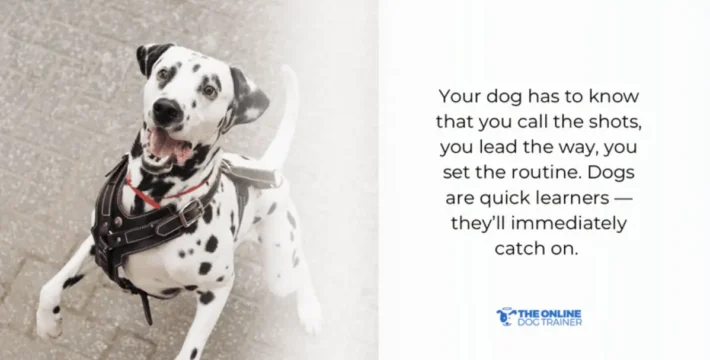
Your dog has to know that you call the shots, you lead the way, you set the routine. Dogs are quick learners — they’ll immediately catch on.
In fact, they catch on so fast that when you allow your dog to dictate the training process, it can significantly stall your training.
When your dog leads the way, it can result to confusion and inconsistency.
What To Do Instead:
Take on the role of a leader by setting clear expectations, providing guidance, and being proactive in shaping your dog's behavior.
My program, the Dog Calming Code™, can help you take the steps in becoming the leader in your dog’s eyes.
All you need to do is change a few of the everyday things you are already doing with your dog.
By so doing, this which will change how they see you in terms of leadership and who is actually in charge!
YOU CAN CHANGE YOUR REACTIVE DOG. THIS FREE CLASS WILL HELP YOU!The leadership training will show you:
- the best approach to controlling your dog’s food
- how to control any danger in and around the home
- the right way to respond to your dog when you return home
- what to do to take charge of the walk.
Giving In to Your Dog
Let’s be honest — our dogs are adorable! Their puppy eyes can easily win us!

But let me tell you this: don’t let the puppy eyes win!
Yielding to your dog's demands or allowing them to get away with undesirable behaviors undermines the training process.
A habit of simply giving treats freely or giving them cuddles even after a rowdy episode can affect dog training negatively.
What to Do Instead
Establish and enforce consistent boundaries, rewarding only the desired behaviors and redirecting or ignoring unwanted ones.
Showing Impatience
I always tell this to new and veteran dog trainers: patience is a powerful partner.

Our dogs can catch even the slightest sign of impatience which could make them lose confidence in us.
Also, our impatience can result in relationship issues that can make dog training more difficult.
What to Do Instead
Impatience can hinder progress and frustrate both you and your dog.
Instead, practice patience and understand that training takes time. Break down tasks into manageable steps and celebrate small victories along the way.
FROM CHAOS TO CALM: THIS FREE CLASS WILL MAKE IT POSSIBLE!Comparing One Dog to Another
Each dog is unique and learns at their own pace. Comparing your dog's progress to others can create unrealistic expectations and discourage you.
What to Do Instead
Instead, focus on your dog's individual progress and celebrate their achievements based on their own abilities.
Not Giving/Forgetting to Give Rewards
Consistent reinforcement is crucial for effective training. Dogs understand good and bad behavior better with rewards.
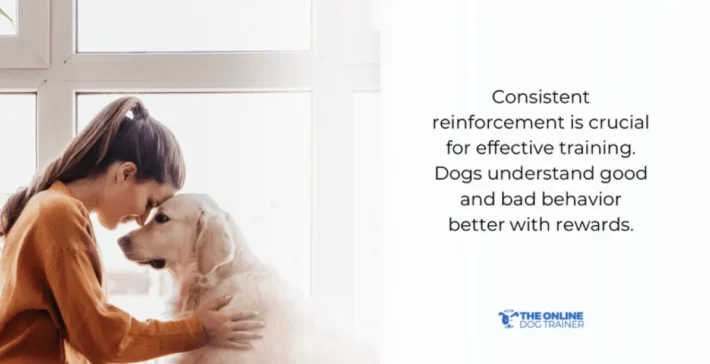
Forgetting to reward or withholding rewards can demotivate your dog. Even while progressing, they can ask “Am I really doing things right?”
What to Do Instead
Never underestimate positive reinforcement using treats, praise and affection.
Positive reinforcement will be more effective when you reward good behavior promptly with treats, praise, or play to reinforce your dog’s learning.
6 Seemingly Harmless Factors That Make Dog Training Fail and What To Do Instead
Question #1: Have You Established Leadership Between You and Your Dog?
Establishing leadership between you and your dog is paramount for successful training. Dogs are pack animals, and they instinctively look for a leader to follow.
Without clear leadership, training can become challenging and less effective.
Leadership is not about being harsh or dominating; it's about earning your dog's respect through fair and confident interactions.

Show calm assertiveness, provide clear direction, and reward positive behavior to reinforce your role as the leader.
And always, always, make sure you doing the foundational work of implementing the rules of the Dog Calming Code™.
This is what your dog will see and respond to almost instantly and hand over the leadership reigns to you.
You must control the food, and show them you control what is danger and what is not. It is your role to show them that you only do things on your terms, not on theirs, and you show them you control the walk.
Question #2: Have You Been Training Your Dog Inconsistently?
Consistency is crucial for successful training. Instead of training sporadically, try to work on your dog's established behaviors randomly and regularly throughout the day.
Question #3: Do You Find Yourself Repeating Commands Over and Over Again?
Once you are confident that your dog understands a command, avoid repeating it excessively.
In such cases, take your dog to a quiet place and attempt the command again. If there's still no response, go back to basics and retrain the behavior.
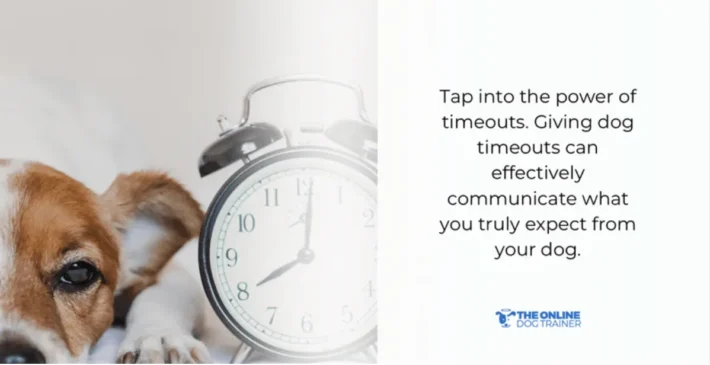
Also tap into the power of timeouts.
Giving dog timeouts can effectively communicate what you truly expect from your dog. In my previous blog, I wrote about timeouts and how to really make it work. Don’t forget to check it out.
JOIN THIS FREE CLASS AND SEE YOUR DOG TRANSFORMQuestion #4: Are Your Training Sessions Too Long or Too Short?
It's important to find the right balance in training session duration. Sessions should typically last around 20 minutes to maintain your dog's focus.
If your dog appears bored, consider shortening the session and concluding it on a positive note.
Question #5: Have You Exposed Your Dog To Different Training Environments?
Starting in a safe and enclosed area is recommended, but as your training progresses, it's beneficial to expose your dog to various environments, such as different locations, people, and animals.
This helps your dog become more responsive in diverse and busy situations.
Question #6: Are You Relying Too Heavily on Treats and Not Enough on Praise and Esteem?
Treats are helpful for teaching new behaviors. However, once your dog understands the behavior, start substituting treats with praise, play, or other forms of positive reinforcement that your dog enjoys.

Question #7: Do You Display Emotional Consistency During Training Sessions?
Training with force, anger, or irritation can intimidate your dog and create a negative training environment.
On the other hand, training with excessive energy, high-pitched excitement, and forced elation can also hinder learning.
Aim for a calm, kind, and confident approach to achieve the best results.
JOIN HERE AND GET FREE ACCESS TO DOGGY DAN'S BESTSELLING PROGRAMQuestion #8: Are You Tailoring Your Training to Accommodate Your Dog's Quirks and Personality?
Just like human children, dogs have unique personalities and quirks that affect their learning styles.
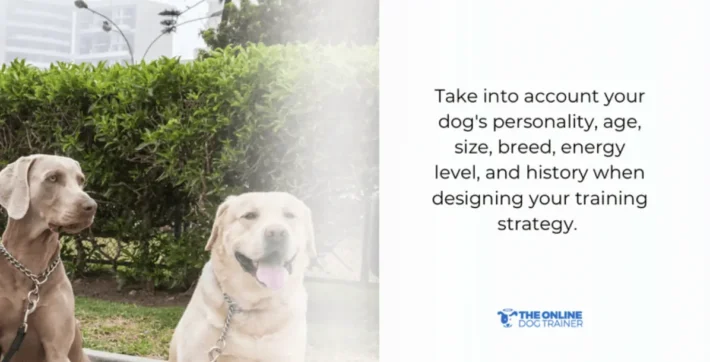
Take into account your dog's personality, age, size, breed, energy level, and history when designing your training strategy.
Adapt your approach to meet your dog's specific needs, whether it requires building confidence in a shy dog or providing structure for an energetic, boisterous dog.
How to Make Dog Training Successful: When to Ask Professional Help
An effective and successful dog training strategy almost always includes a dog trainer or take an online program about dog training!
Let’s talk about the factors that tell you “It’s time to get professional help!”
Factor #1: Lack of Progress or Frustration
If you've been consistently working on training your dog but haven't seen any significant progress or are feeling frustrated, it may be time to seek the help of a professional dog trainer.
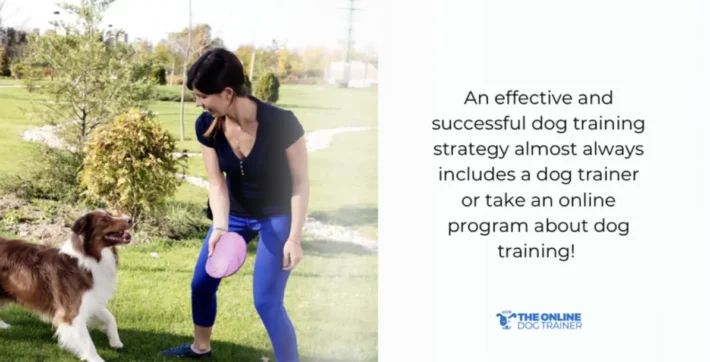
They can provide guidance, expertise, and fresh perspectives to overcome training challenges.
Factor #2: Behavior Issues
If your dog displays persistent behavior problems such as aggression, excessive barking, separation anxiety, or destructive behaviors, a dog trainer can help address these issues.
They can assess the root causes, develop behavior modification plans, and provide effective strategies to manage and modify problematic behaviors.
FREE WEBINAR: LEARN THE FIVE GOLDEN RULES 100% FREE!Factor #3: Inconsistent Obedience
If your dog consistently ignores commands, has difficulty following instructions, or only responds sporadically, guidance from a dog trainer (or from their online program) can assist in improving their obedience.
They can teach you effective communication techniques and implement training methods that encourage consistent responses from your dog.
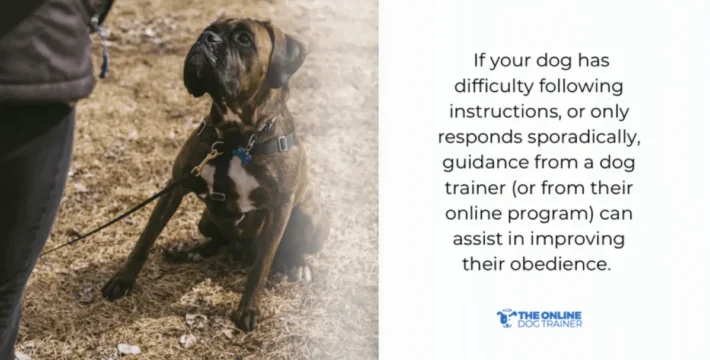
Factor #4: Socialization Challenges
If your dog exhibits fear or aggression towards other dogs, animals, or people, proper socialization becomes crucial.
A dog trainer or online training program can guide you in desensitizing and counterconditioning your dog. It can help them become more comfortable and confident in various social situations.
Factor #5: Specific Training Goals
If you are wondering how to make dog training successful, a guidance from a professional dog trainer can help.
A dog trainer (or an online training program from one) can provide targeted instruction and guidance.
They can help you and your dog reach your goals effectively and efficiently.
Factor #6: New Dog Owner
If you're a first-time dog owner, a dog trainer’s help can be immensely beneficial. With their help, you will begin to understand basic obedience, house training, and even your dog's behavior.
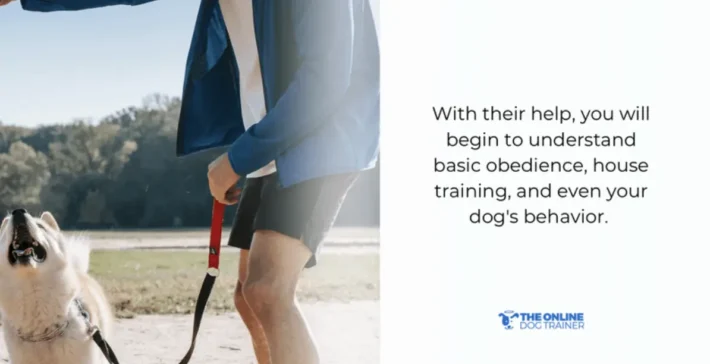
They can equip you with the knowledge and skills needed to establish a strong foundation for a well-behaved and happy canine companion.
Factor #7: Personal Circumstances
If your personal circumstances — such as a demanding schedule, physical limitations, or health concerns — prevent you from dedicating sufficient time and effort to training, a dog trainer can step in to support you.
A professional perspective (and experience!) can make dog training successful by providing guidance, and assistance to ensure your dog receives the necessary training and care.
Dog Training Video Courses: Getting Guidance From a Professional Dog Trainer in the Comfort of Your Own Home
Thanks to technology, you no longer have to travel long distance just to get expert help.
As a dog trainer, I made it a goal to reach even those far from me so they can achieve the behavioral goals they want for their dogs.

My two popular video courses — the Dog Calming Code and the Puppy Coach — has helped tens of thousands of dog owners. Without them or me needing to travel OR pay crazy fees!
If you want to learn the foundations of dog training plus so much more from a top dog trainer in your own home — and in your own pace — don’t forget to check out my courses.
LEARN REACTIVITY FOR FREE: THIS CLASS WILL CHANGE YOUR DOG FOR GOODThe Benefits of Choosing Online Dog Training Programs
If there is no dog trainer near you, or traveling to one isn’t an ideal option, you can consider online dog training programs.
When you go for an online dog training program made by an actual dog trainer, you get the benefits without the high cost. Plus, you’re going to train your dog yourself.
Isn’t that amazing?
Here are other benefits of online dog training courses that you can also enjoy.
Factor #7: Personal Circumstances
Online dog training programs allow you to learn at your own pace.
You have the freedom to set your training schedule, ensuring that it fits seamlessly into your busy life.
You have the freedom to set your training schedule, ensuring that it fits seamlessly into your busy life.
This flexibility enables you to adapt the training sessions to suit your dog's learning style and progress gradually.
Cost-effectiveness
Compared to traditional in-person training methods, online dog training programs offer a more affordable option.
You can save on expenses such as travel costs, registration fees, and the need to purchase specialized equipment. This cost-effectiveness allows you to access expert guidance without breaking the bank.
Convenience
With online dog training programs, you can access expert guidance and valuable resources from the comfort of your own home.
There's no need to worry about geographical limitations or time constraints. The convenience of learning remotely allows you to focus on the training process without the hassle of commuting or scheduling conflicts.
THIS FREE CLASS WILL REVERSE YOUR DOG'S REACTIVITY IN JUST DAYS!Accessibility
Online dog training programs provide access to expert trainers and valuable insights regardless of your location.
These programs ensure that you have access to high-quality training materials and guidance wherever you are.
Revisit and Adaptability
Online courses serve as a valuable resource that you can revisit as often as needed. This allows you to reinforce your learning, refresh your knowledge, and adapt the training techniques to suit your dog's individual needs.
You can revisit specific modules or lessons, ensuring a comprehensive understanding of the training concepts.
How To Make Dog Training Successful: Have a Clear Goal, and a Clearer, Consistent Message
In the world of dog training, the answer to “How to make dog training successful?” lies in having a clear goal and a consistently communicated message.
As you embark on this training adventure with your furry companion, remember to stay focused, be patient, and maintain a consistent approach.
Celebrate the small victories along the way and never lose sight of your ultimate goal.
By having a clear goal and a clearer, consistent message, you are not just training your dog. You are also building a lifelong bond based on trust, understanding, and effective communication.
Embrace the power of a clear goal and a consistent message, and let the journey of successful dog training begin.
The possibilities are endless, and — with consistency in your message and routine — you’re one step closer to success.

~Doggy Dan 🙂







4 Responses
Such a great article. We can definitely relate to what you are saying, especially about the ‘repeating commands’ part you mentioned above. As trainers, we really have to drill this home to our human clients!
We are just starting out and its great to see such excellent information here. Thank you.
You’re welcome
I just wanted to say thanks for sharing your knowledge it’s like a light at the end of a tunnel for a positive outcome again thanks .
Thanks for your feedback Joseph, and I am really happy that you found my Blog so helpful! My aim is to help educate dog owners so that their understanding & relationship with their dog/s improves. So there is no need to thank me for doing that, but I appreciate it! All the Best, Doggy Dan